
The development curve is flattening off in conventional tantalum electrolytic capacitors, so alternative technologies are in demand. The magic words enchanting designers now are 'niobium', 'polymer' and 'multianode' technologies - innovations that promise the highest volumetric capacitance and lowest equivalent series resistance.
Over the past two years, computer and telecom markets have grown vigorously and generated considerable demand for tantalum capacitors in particular. In the telecom arena, interest in tantalum capacitors has been spurred by mobile phones and base stations as well as network infrastructures and equipment for fast Internet access. With the high data transfer rates required by impending networks and mobile communication systems (eg ADSL, UMTS), the communications and computing markets are sure to merge in the future. Even as the market turns from allocation to overcapacity in the current consolidation phase, the driving trends of the electronics industry are still miniaturisation and innovation.
Tantalum trends
There is a distinct trend in tantalum capacitors toward higher capacitance combined with a growing demand for lower equivalent series resistance (ESR). In computers, especially notebooks, tantalum capacitors serve as buffer and smoothing capacitors in power supplies for the main board and processor, disk drives, and other plug-in modules. From one processor generation to the next, power consumption has increased with higher scales of integration and rising clock frequencies.
Whereas a Pentium III microprocessor, for example, drew 16 to 17 A, a Pentium 4 now requires 40 to 46 A. Compounding this, a high start-up current is required when the processor activates from sleep mode. And, during current transitions, the operating voltage must remain within a restricted acceptance window. This is a tough challenge for power supplies and for the tantalum capacitors in them. These components must handle high, steep current slopes and prevent the voltage from dropping out of the window of acceptance.
Tantalum chip capacitors meet today's requirements. In the future, even higher volumetric capacitance and lower ESR will be obtained with niobium capacitors in polymer and multi-anode technology.
Tantalum capacitors are produced by pressing porous pellets from a fine, capacitor-grade tantalum powder. The pellets are then sintered to increase mechanical stability and create a metallic structure where the dielectric layer of tantalum pentoxide (Ta2O5) can be grown by anodic oxidation.
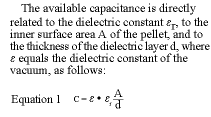
Until now, the driving force behind higher CV values has been powder morphology combined with better space utilisation of the case size. Currently, tantalum powder with up to 80 000 CV/g is available, but this is only used commercially in smaller sizes (0805, case size A). To meet the market demand for miniaturisation and higher CV values, new approaches must be taken. One opportunity was to use a different base material - niobium.
Higher CV values with niobium
Niobium's chemical properties are similar to tantalum's. Niobium belongs to the same group in the periodic table of elements, so it builds up the dielectrical niobium pentoxide (Nb2O5) by anodic oxidation (pre-forming process) just as well as tantalum does tantalum pentoxide (Ta2O5). The major advantage of niobium pentoxide over tantalum pentoxide is a higher dielectric constant of 41 versus 27.
The use of niobium for capacitors is not new. In fact, it was utilised in the '50s, mainly in the former Soviet Union. But the lack of sophisticated powder technology for niobium production with regard to morphology and purity, combined with the inability to produce a high-CV niobium powder, prevented broader use of niobium in world markets.
What is new is a better-developed powder production capability, which gives niobium a significant edge over tantalum in terms of CV values in the medium term. The road map for powder morphology targets the region of 300k CV/g. Because niobium has about half the density of tantalum, component manufacturers can still make niobium capacitors with about twice the capacitance possible with today's tantalum powder in the 80k CV/g region.
Overcoming oxides
But niobium does present difficulties. As well as niobium pentoxide, 'real' dielectric suboxides such as NbO and NbO2 (which do not exist in tantalum oxide systems) are partly present in a niobium oxide system. These suboxides are metallic conducting and semiconducting respectively, which leads to a potential risk of higher leakage current or even failures in a capacitor. The higher oxygen solubility in niobium, as compared to tantalum, further supports the forming of suboxides in a niobium/niobium oxide layer system, especially at elevated temperatures. Development of niobium capacitors must therefore overcome the forming of suboxides and stabilise the dielectric layer too.
Two approaches will meet this challenge. With more sophisticated powder development and process adjustments in the manufacturing of niobium capacitors, the deterioration of the dielectric layer can be avoided. EPCOS has made tremendous efforts on both these fronts. Initial results for niobium capacitors developed by EPCOS are presented in Figure 1, which shows the variation of capacitance with temperature compared in niobium, tantalum, aluminum electrolytic and ceramic capacitors. The obvious stability of the niobium capacitor is based on the chemical affinity between tantalum and niobium. Between -55 and 125°C, the drift range for niobium capacitors is narrower than ±20%, while ceramic capacitors lose up to 80% of nominal capacitance. As in tantalum capacitors, the counterelectrode of niobium capacitors consists of manganese dioxide (MnO2), created by impregnation of the sintered and formed anodes in manganese nitrate and subsequent pyrolysis as solid MnO2. The counterelectrode has a decisive effect on ESR. Not surprisingly, variation of ESR with frequency is almost identical in niobium and tantalum capacitors.
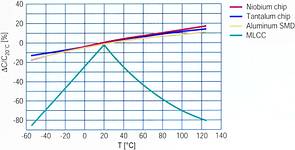
Niobium capacitors have a higher DC leakage current - a maximum of two to four times that of tantalum capacitors. For most applications, this is not a problem, since the maximum current usually remains below 50 µA. Compared with the total power consumption of microprocessors, these figures are low and insignificant. The more important question is the reliability of niobium technology. As demonstrated in life tests, DC leakage current increases over time, but the increase diminishes after several hundred hours, and saturation occurs.
Raising the ceiling to 125°C
Even niobium capacitors with a modified powder and a modified production process showed less increase and lower DCL values in life tests. Niobium capacitors will be able to operate between -55 and +105°C. The voltage range from 4 to 16 V will serve the high-CV market. First results show that design rules similar to those for tantalum capacitors are valid. Above 85°C, derating down to two-thirds of rated voltage is complementary; while a derating factor of two is recommended for surge conditions to maintain a low failure rate.
Even if the 100k niobium powder currently available does not yet offer a major advantage over tantalum in terms of maximum volumetric capacitance, the technology for manufacturing niobium powder and niobium capacitors will continue to advance toward higher CV values, lower overall leakage current, and an extended temperature range up to 125°C. Recent results for the stability and reliability of niobium capacitors are very promising.
With 300k CV/g niobium powder (which will be available in the near future), either a 1500 µF/10 V capacitor in case size E or a 47 µF/10 V capacitor in case size A can be produced, since this technology is not limited to case size. If the development goals mentioned are reached within the next year, niobium capacitors can be used in applications requiring extremely high capacitance in a minimum of board space without changing any design rules. Finally, as niobium ore is much more abundant and less expensive than tantalum ore, niobium technology will soon gain market share.
Lowest ESR values
Most manufacturers of tantalum capacitors have a standard series and a low-ESR series in their product spectrum. The latter offers ESR values in the region of several hundred milliohms at 100 kHz, depending on case size and rated voltage. The larger the case size, the lower the ESR, because the outer surface of the anode partially determines ESR. In addition, the electrical conductivity of the cathodic material determines impedance and thus ESR. Two technologies are now available for further reduction of ESR: polymer and multi-anode technology (Figure 2).
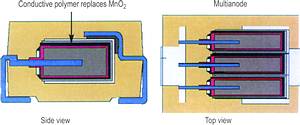
Polymer technology replaces the cathodic MnO2 material of the counterelectrode by highly conductive polymer, reducing ESR in general, by a factor of two to three (Figure 3). The most commonly used polymer on the market is polypyrrol, which has about 100 times the conductivity of manganese dioxide. These polymer capacitors usually operate in the temperature range from -55 to +105°C, some at up to 125°C.
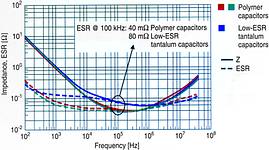
The polymer coating is formed by dipping the oxidised tantalum anodes in a monomer solution, followed by chemical or electrochemical polymerisation. In both polymerisation processes, the porous anode must be impregnated with the monomer solution; this is done in numerous steps to completely cover the porous structure and the dielectric layer. Best results can be obtained for anodes with small diffusion pathways for the monomer solution. Low-profile anodes for 3210L cases (low-profile D) are preferred, but tantalum polymer capacitors in D and E cases are also available.
The second approach to reducing ESR is multi-anode technology. This can only be used in large case sizes, such as case E. This technique increases the outer cathodic contact area by connecting multiple anodes (eg three low-profile anodes) in parallel. In comparison with a single-anode configuration, ESR is reduced by a factor of three, equal to the number of anodes connected.
Combining technologies for optimum design
By combining these technologies, capacitors can be implemented that feature the highest volumetric capacitance and lowest equivalent circuit resistance. A superlow-ESR tantalum capacitor for large case sizes can be creating by coating the anodes of a multi-anode capacitor with conductive polymer. If polymer anodes are used, ESR is reduced by a factor of up to three, while multi-anode technology reduces it by a factor of three again, resulting in a tantalum capacitor with single-digit ESR (Figure 4).
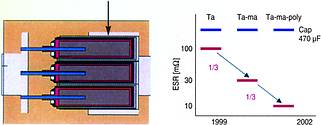
The ultimate supercapacitor can be created by using niobium instead of tantalum, combined with a highly conductive polymer coating and multi-anode technology. Capacitors can thus be implemented with single-digit ESR and capacitances rivalled only by aluminium electrolytic capacitors of much larger volume and lower volumetric capacitance. The combined use of polymer and multi-anode technologies reduces ESR to about one-tenth of that of low-ESR tantalum capacitors. And assuming the use of 300k CV/g niobium powder, niobium will increase volumetric capacitance by a factor of two to three over today's values (Figure 5).
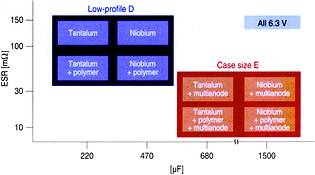
Summary
Combination of innovative technologies will make it possible to implement capacitors with ratings of 1500 µF and minimal equivalent series resistance in case size E.
* Multi-anode technology reduces ESR by a factor of 3.
* Polymer technology reduces ESR once again by a factor of 3.
* These two technologies combined reduce ESR by a factor of up to 10.
* Niobium capacitors can be implemented with at least twice the volumetric capacitance of tantalum chips.
* Combination of all three technologies will usher in the supercapacitor of the future rated at 1500 µF/6,3 V in case size E with an ESR of less than 10 m.
| Tel: | +27 11 458 9000 |
| Email: | [email protected] |
| www: | www.electrocomp.co.za |
| Articles: | More information and articles about Electrocomp |

© Technews Publishing (Pty) Ltd | All Rights Reserved